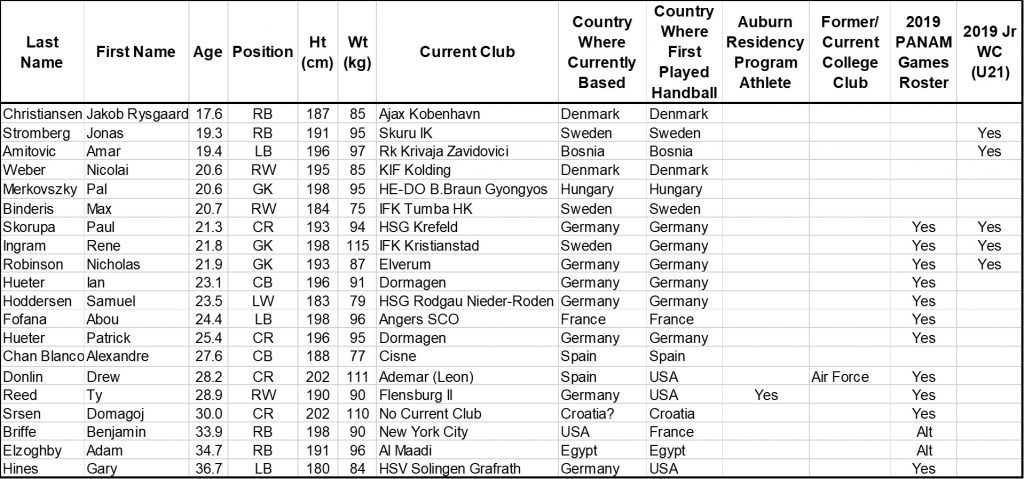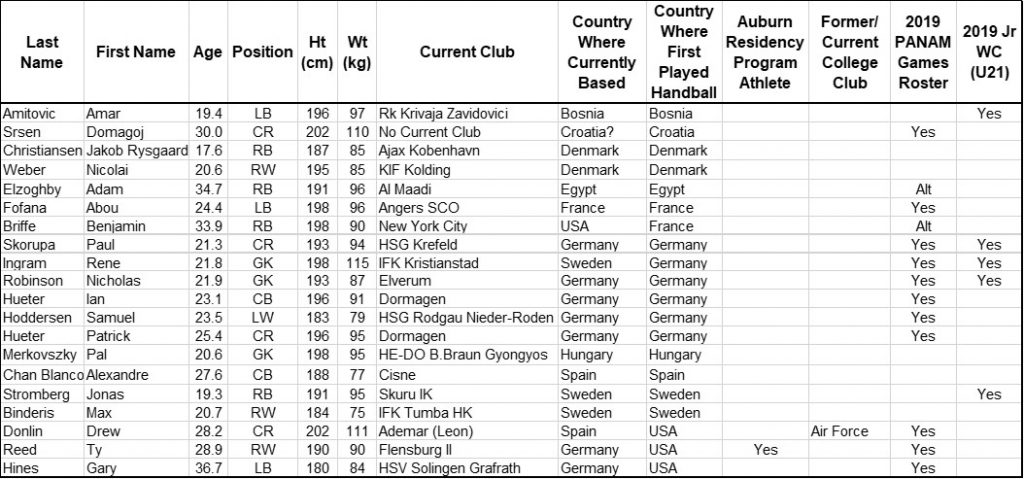Coach Robert Hedin and the selection committee have released the official 20 man roster for the 2021 IHF Men’s World Championships. Here’s a review of the roster from a few different perspectives.
U.S. Roster (By Age)

The 20 man roster ranges from 17 Jakob Rysgaard Christensen) to 36 (Gary Hines) and has a very young average age of 23.5. Five of the athletes (Jonas Stromberg, Amar Amitovic, Paul Skorupa, Rene Ingram and Nicholas Robinson) were on the U.S. Jr World Championships team and Pal Merkovsky was on the Hungarian Jr World Championship team.
Much has been said and written about the U.S. getting an unwarranted helping hand to participate in this championship. That the U.S. didn’t earn it’s slot. There’s some truth to that, but no one can argue with one of the rationales for the U.S. bid: That participating in this World Championship will help develop athletes in preparation for the 2028 Olympic Games.
It’s difficult to project out 7.5 years, but the bulk of this talented and youthful roster has a future with the U.S. National Team. We will be seeing several of these athletes in a U.S. uniform in Los Angeles at the 2028 Olympic Games. How many? I’m thinking 5, but it could be as many as 10.
U.S. Roster (By Nation Where Athletes First Played Handball)

All of these athletes are Americans, but the U.S. is a large nation with a global population. Estimates vary, but as many as 9M American citizens live in another country so it’s no real surprise that some of those 9M learned to play handball where they grew up. In fact, 85% (17 of 20) of the U.S. roster originally played handball in 13 different countries. Germany leads the way with 6 athletes while Denmark, France and Sweden have 2 each. Other nations: Bosnia & Herzegovina (1), Croatia (1), Egypt (1), Hungary (1), Spain (1).
(The fact that the U.S. has so many dual citizen athletes is sometimes seen as controversial, but it shouldn’t be. I addressed this reality and its implications for the U.S. National Team and the sport’s development previously in a series of commentaries Part 1, Part 2, Part 3)
In terms of the 3 U.S. athletes that were raised stateside, 1 athlete (Drew Donlin) first learned to play at a college club (Air Force), 1 athlete (Ty Reed) is a product of the former Auburn Residency Program and 1 athlete (Gary Hines) was a product of an Atlanta based youth program and the Condors club.
U.S. 20 Man Roster (By Position)
When the 35 Man Provisional Roster was released I did a projection of who I thought would make the Final 20 Man Roster. I was 17 for 20. Here’s a closer look at the 20 Man Roster with some analysis as to why these athletes were selected.
USA Left Wings

Only PANAM Games veteran, Sam Hoddersen, made the 20 man roster. I projected that Lukas Hansen would also make the cut, mostly based on the fact that he plays for a top division Danish Pro Club, Fredericia HK. I’ve heard there may be some issues with his passport, but I don’t know if that was the deciding factor or not. The fact that only 1 left wing was selected and 4 right backs were taken leads me to believe that we will also see a lot of Gary Hines at left wing as well.
USA Left Backs

It was pretty much a given that Fofana and Hines would be selected, but it was less clear who else might get selected here. I had chosen Seb Wheeler based in part on his PANAM Games Alternate selection last year, but the coaching staff went with Amar Amitovic.
USA Center Backs

Again, there was zero doubt that the Team Captain, Ian Hueter and newcomer, Alexandre Chan Blanco, who leads his Liga Asobal club, Cisne, in scoring would make the team, but I went with Amir Seifert as the 3rd option. The coaching staff decided to just take 2 center backs and have identified Michael Williams and Philipp Scholz as potential replacements.
Also, another factor to take into account. Chan and Hueter might both be worthy of starting and playing a lot of minutes. I won’t be surprised to see both of these athletes on the court at the same time with one of them moving to left or right back.
USA Right Backs

For me right back was the hardest position to project. The PANAM Games roster had no true right backs on its roster. A situation that was problematic at times. Now for the World Championships the U.S. will have 4 right backs. However, each of these athletes have question marks. Briffe played professionally in France, but hasn’t been able to play indoors in the U.S. due to the pandemic. Elzoghby played great for the U.S. back in 2010-11 but was less impressive in friendlies last year. Stromberg played well at Jr World’s, but is he ready for the Sr level? And, of course, the same is true for Christiansen who is just 17. (He must really have potential to be selected at that age). I suspect that the coaching staff (like me) is a little in the dark and will use the training camp to figure out who emerges from these 4 options.
USA Right Wings

I only projected Reed and Binderis getting selected here, but Nicolai Weber must also have impressed with his game film. Reed is the projected starter and I suspect the coaching staff will use the training camp to evaluate who will be the primary backup.
USA Circle Runners

The U.S. is well stocked at circle runner and I think these four athletes will all get significant playing time. And, we will likely see two circle runners playing on offense some of the time and on defense most of the time with one of these 4 also subbing in as a defensive specialist. Alex Binderis is the victim of a deep depth chart and was selected as an alternate.
USA Goalkeepers

Last year, I thought the U.S. was lucky to have 2 young, quality goalkeepers with a future. Now we have 3? And, the new addition, Pal Merkovsky, may even be better. That’s crazy good fortune. It should be a great training camp with all 3 GKs looking to impress the coaching staff. I know nothing about the other 2 GKs selected as alternates, but in this time of COVID, where multiple positive test results is a real threat, keeping extra GKs as alternates that can be called up is a wise move.
Previous Articles Assessing the USA Men’s Player Pool